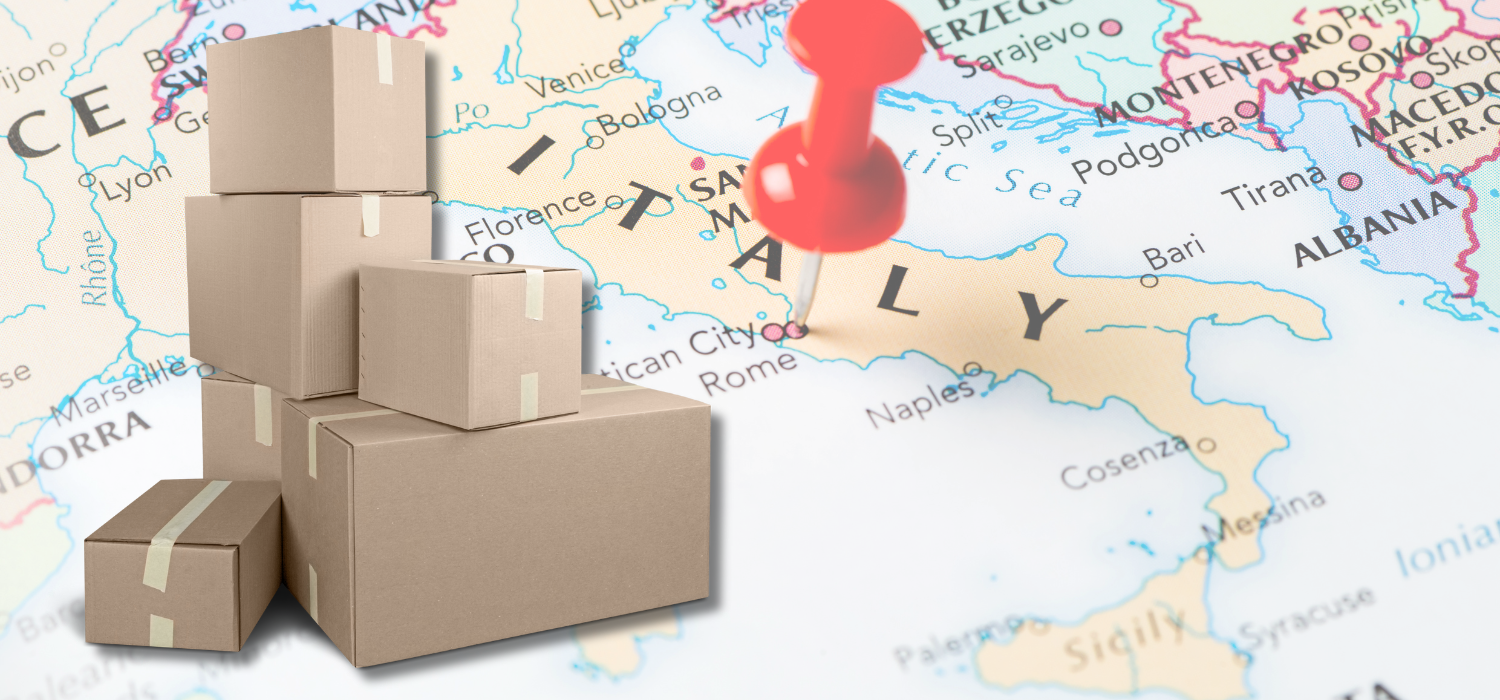Italian e-commerce is no longer ’emerging’: it is mature, international and mobile-first.
This is not an opinion, but data collected by Landmark Global in the Country Factsheet Italy 2025 and published at the end of September 2025.
In this piece, we line up the facts – with percentages, orders of magnitude and purchasing behaviours – and translate them into insights for those who sell online in Italy. Let’s get started!
The Italian e-commerce market in one figure: €85.4 billion
The value of e-commerce in Italy is €85.4 billion in 2025. This is the clearest picture of the health of the sector: a now solid and expanding market that consolidates years of growth and makes Italy one of the most interesting markets in Europe in terms of scale and potential.
There are 25 million online shoppers in Italy, with an average annual spend of €2,500. This figure reflects a mature consumer base that is accustomed to shopping online.
But let’s get down to facts: what are the trends that will truly define the Italian market in 2025?
Trends in the Italian e-commerce market in 2025
Fact #1: Italy buys (also) across borders
Almost 4 out of 10 purchases are international, accounting for 39% of total e-commerce. This figure explains two things: the hunger for variety – both in terms of brands and assortment – and sensitivity to the quality of services offered (prices, duties, delivery methods).
For Italian merchants, this means global competition within every shopping cart. For foreign brands, Italy is an open market with users accustomed to crossing digital borders.
Fact #2: Italians diversify their cross-border shopping destinations
China remains the number one destination for cross-border purchases, but the map is becoming more balanced: Germany (27%) and the United Kingdom (20%) are falling slightly behind, while France (20%), Spain (18%) and the United States (18%) are advancing.
Among the surprises, Switzerland stands out, signalling that consumers are increasingly open to nearby and alternative solutions. The result is a more diversified portfolio of countries, with less concentration and more regional possibilities.
Fact #3: Fashion drives purchases, but the basket is expanding
In cross-border choices, clothing and footwear are the most purchased category, with 35% of preferences. This is followed by consumer electronics (24%) and home and garden products (21%). Sports and leisure (15%), toys (9%) and personal care & beauty (10%) are also growing.
The shopping basket is thus becoming more varied than in previous years, and fashion’s primacy is giving way to an increasingly balanced mix of lifestyle and tech interests.
Fact #4: Italians shop online for speed and simplicity
The drivers of cross-border shopping in 2024/2025 are very clear:
- Speed of delivery: 36%
- Ease of finding products: 34%
- More choice of products/brands: 33%
- Reliability of delivery: 31%
- Low price: 27%
The picture is clear: affordability remains important, but the main factors driving choices are the certainty of fast delivery and the convenience of a frictionless shopping experience.
Fact #5: Italians are spending more
Lower-value purchases are losing ground: transactions under £25 are gradually declining, while the proportion of those who spend more is growing.
Today, almost one in two orders (49%) exceeds £50, a figure that signals growing confidence and maturity among online consumers.
The dynamic is clear: when payment systems work smoothly, tracking is transparent and returns are simple, users feel more confident and increase the value of their shopping carts.
The overall distribution speaks for itself: 5% under £10, 20% between £10 and £24, 26% between £25 and £49, and 49% over £50.
Fact #6: Smartphones dominate online shopping with 47% of purchases
If definitive confirmation was needed, it has arrived: almost half of cross-border purchases (47%) are made on smartphones. Laptops (27%), desktops (20%) and tablets (6%), now marginal, follow at a distance.
This means that the mobile experience is no longer optional. Intuitive interfaces, fast payments and streamlined checkouts are now at the heart of e-commerce. Those who do not optimise for mobile risk losing almost one in two customers in a market where digital friction can translate into immediate cart abandonment.
Fact #7: Italian parcels remain light, but the medium weight range is growing
The trend in parcel weight remains stable, but with a clear prevalence of the 0.6–2 kg range, which alone accounts for almost half of all shipments (49%).
This is followed by lighter parcels, under 0.5 kg (37%), which, however, continue to decline compared to previous years. Medium-sized shipments, between 2.1 and 5 kg, account for 10%, while larger parcels, over 5 kg, account for 4%.
This picture suggests that Italian e-commerce mainly deals with medium-lightweight orders, which require optimised logistics in that particular range.
The challenge is not only to transport lighter parcels, but also to ensure widespread efficiency in the last mile, where speed and punctuality make all the difference to the customer experience.
Fact #8: Home delivery dominates, but lockers and collection points are growing
Home delivery remains the most popular choice in Italy (41%), but the landscape of consumer logistics preferences is changing rapidly.
Out-of-home delivery solutions offering greater autonomy and flexibility are growing: 37% choose collection at a post office, 30% opt for a parcel locker, while 29% prefer delivery to their letterbox or a secure location at home.
These figures show that Italian consumers no longer want to simply receive their parcels at home, but want to decide how and when to collect them, choosing the most convenient option according to their daily habits.
This transformation is not just a logistical detail, but a real disruption of the customer journey: if until a few years ago ‘fast delivery’ was the strongest promise, today the differentiating factor is convenient delivery.
For retailers and brands, integrating Out of Home delivery methods means not only catering to a growing preference, but also reducing the risks of non-delivery and the associated costs, lowering the related return rate and improving customer satisfaction.
This is where GEL Proximity comes in. With an extensive network of over 500,000 collection points and lockers and easy-to-activate digital integrations on eCommerce sites, our solutions respond to consumers who are increasingly attentive to sustainability, convenience and transparency, offering a truly flexible delivery experience in line with new purchasing habits.
Do you want to offer your customers a truly modern delivery experience? Find out how GEL Proximity can integrate the best Out of Home delivery services into your online store.
Fact #9: Sustainability drives consumer choices
Sustainability is no longer just a talking point, but a concrete criterion in purchasing decisions.
- 69% of consumers say they always recycle the packaging they receive
- 61% prefer retailers to use recyclable materials
- 62% are willing to accept slower deliveries in order to reduce environmental impact
- 59% disapprove of overpackaging
Being ‘green’ is therefore becoming part of everyday behaviour, not just an advertising slogan. Packaging, delivery times and logistics processes are now under the scrutiny of consumers, who reward brands that combine efficiency with environmental responsibility.
Fact #10: transparency comes first
When it comes to e-commerce, clarity is the keyword for Italian consumers. Even more important than price or speed, what really matters is knowing how much delivery will cost, how returns will work and what shipping options will be available.
- 62% want clear information on delivery costs before completing their order.
- 60% consider simple and reliable returns to be essential.
- 58% appreciate free shipping thresholds.
- Also, 58% want low and transparent duties on purchases from abroad.
- 51% say that trust in the courier is a determining factor in their purchasing decision.
Added to this is a now universal behaviour: 90% of Italians track their parcels via notifications, demonstrating that monitoring the progress of an order is an integral part of the shopping experience. In summary, customer experience is not only about the product, but also about the retailer’s ability to offer transparency and reassurance at every stage, from checkout to delivery.
Beyond the numbers: what the 10 findings tell us about the ‘new’ Italian e-commerce
The picture that emerges is one of a constantly expanding digital market and increasingly demanding and aware Italian consumers. Their habits are becoming hybrid, with mobile devices dominating purchasing choices, sustainability seen as a daily practice and shopping carts gradually increasing in value per unit. Online retailers are therefore measured every day against service standards that go beyond price alone.
In contrast, the data also show the structural specificities of the Italian market. On the one hand, there are regional disparities, with marked differences between the north, centre and south in terms of infrastructure, delivery times and digital penetration. On the other hand, there are the logistical complexities typical of our country: a fragmented geography, large high-density urban areas and less well-served areas that make it more difficult to guarantee fast and economical deliveries.
For this reason, growing in e-commerce in Italy means relying on specialised logistics partnerships and designing a shopping experience tailored to the territory, capable of responding to consumers’ expectations in a differentiated way that is truly close to their daily needs.
For Italian and international retailers, the message is clear: e-commerce needs to be designed around the real customer, the one who buys from their smartphone, reads the terms and conditions before checkout and tracks every stage of the parcel until delivery, preferably outside the home.













